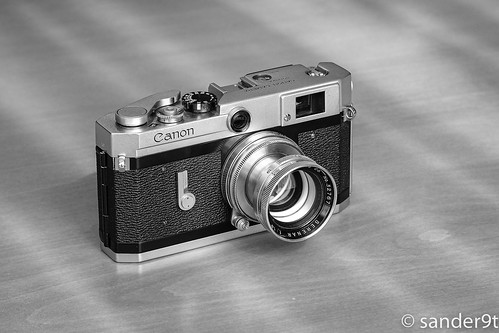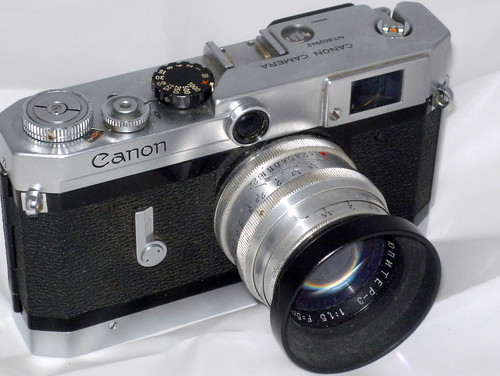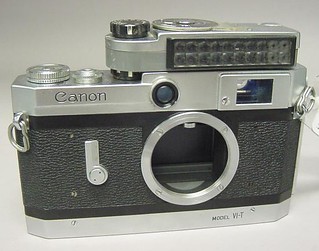Canon VI

|
| Canon VI-L image by Sander Li (Image rights) |

|
| Canon VI-T image by Dan Iggers (Image rights) |

|
| VI-T body with accessory lightmeter image by à Rebours (Image rights) |
The Canon VI-L and Canon VI-T are coupled rangefinder cameras made by Canon in 1958.[1] The two models have almost all features in common, and differ only in the film advance mechanism. The VI-L has an advance thumb-lever at the right-hand end of the top housing, as has become familiar feature of 35 mm cameras. The VI-T has a folding trigger advance built into the base, as on the VT. It is intended to be operated with some of the fingers of the fingers of the left hand, while the index finger and thumb focus. The trigger advance makes the VI-T about 5 mm taller than the VI-L;[2] it is also slightly heavier: 995 g compared to 940 g for the VI-L (both body only).[3] The lever advance model was the more popular of the two,[2] and the successor camera, the Canon 7, was not offered with trigger advance.
Either camera has a focal plane shutter with metal blinds, which travel horizontally. It has speeds 1 - 1/1000 second, plus 'B' and a separate 'X' position for flash synchronisation at 1/55 second. Unlike the Canon V models which preceded them, the Canon VI cameras have all the speeds on the same dial; this allows an accessory lightmeter to be coupled to the shutter speed through the whole speed range. Canon's meter is a dual-range selenium one, measuring EV 4-13 and EV 10-19 at ISO 100 (this is two EV more sensitive than the built-in meter in the Canon 7; and further, a booster unit can extend the sensitivity to EV 2). See the illustration below of a VI-T with such a meter.
The viewfinder has three switchable magnification levels (selected by the wheel control beside the finder eyepiece): 0.65× to serve a 35 mm lens, 1× for a 50 mm, or 1.55× (this setting is simply described as 'magnified' and it is labelled 'Mg', not linked to a particular lens). There are brightline frames for 50 and 100 mm lenses, which are automatically corrected for parallax error. In addition, there is a pin in the accessory shoe, which elevates the front of an accessory viewfinder, if used, and this pin is also coupled to the focus for parallax correction.
The lens mount is a standard 39 mm screw mount. The cameras were sold with standard lenses as fast as f/1.2.
With either film advance mechanism, there is a frame counter which resets when the back is opened. Film rewind is by a folding crank; the collar around the shutter release button has a position to release the film for rewinding.
Notes
- ↑ Canon rangefinder camera series at the Canon Camera Museum; the source of most information here.
- ↑ 2.0 2.1 Canon VI-L at the Canon Camera Museum.
- ↑ Canon VI-T at the Canon Camera Museum.
Links
- Canon VI-L and VI-T user manual at Manualslib
- Canon VI-L sold in the 20th Westlicht Photographica Auction, on 12 November 2011 (several good pictures).
In French:
- Canon VI-T at Sylvain Halgand's Collection Appareils (in French)